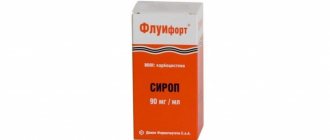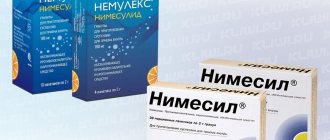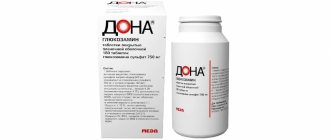Citramon Aquacitramon granules for oral solution 3 g x5
MINISTRY OF HEALTH OF THE RUSSIAN FEDERATION
INSTRUCTIONS
on the use of a medicinal product for medical use
AQUACITRAMON
Registration number: Р N003404/01
Trade name: Aquacitramon
Group name
Acetylsalicylic acid + Caffeine + Paracetamol
Dosage form: granules for oral solution
Composition per package:
Active ingredients:
Acetylsalicylic acid , , , , , , , 0.36 g
Paracetamol , , , , , , , , , , , , , , , , , , , , , , , , , , , , , , , , , , , 0.27 g
Caffeine , , , , , , , , , , , , , , , , , , , , , , , , , , , , , , , , , , , , , , , , , , , , , 0.045 g
Excipients: citric acid - 1.34 g, sodium bicarbonate - 0.782 g, sodium benzoate - 0.048 g, orange flavor - 0.04 g, lemon flavor - 0.02 g, sodium saccharinate - 0.015 g, curcumin dye - 0, 08
Description: a mixture of granules and powder, light yellow in color with a faint citrus odor.
Pharmacotherapeutic group: analgesic, non-narcotic drug (non-steroidal anti-inflammatory drug + psychostimulant + non-narcotic analgesic).
ATX code: [N02BA71]. ,
PHARMACOLOGICAL PROPERTIES.
The drug has analgesic, antipyretic and psychostimulating effects.
Acetylsalicylic acid has analgesic, antipyretic and anti-inflammatory effects, inhibits platelet aggregation. Paracetamol has an antipyretic and analgesic effect. Caffeine reduces drowsiness and fatigue, increases mental and physical performance, increases heart rate, and increases blood pressure.
with hypotension.
Indications for use
Aquacitramon is used in adults for moderate or mild pain syndrome (headache, toothache, neuralgia, myalgia, thoracic radicular syndrome, lumbago, arthralgia, pain during menstruation
etc.), in adults and children over 15 years of age to reduce elevated body temperature, for “colds”
and other infectious and inflammatory diseases.
Contraindications
Increased individual sensitivity to the components of the drug, erosive and ulcerative lesions (in the acute phase) of the gastrointestinal tract, gastrointestinal bleeding, increased tendency
to bleeding, “aspirin asthma”, hemorrhagic diathesis (hemophilia, von Willebrand disease, telangiectasia, hypoprothrombinemia, thrombocytopenia, thrombocytopenic purpura), dissecting aortic aneurysm, portal hypertension. Vitamin K deficiency. Glucose-6-phosphate dehydrogenase deficiency. Pregnancy (I and III trimester) and breastfeeding period.
The drug is not prescribed as an analgesic to persons under 18 years of age, and as an antipyretic to children under 15 years of age with acute respiratory diseases caused by viral infections, due to the risk of developing Reye's syndrome (encephalopathy and acute fatty liver degeneration with acute development of liver failure) .
With caution - hyperuricemia, urate nephrolithiasis, gout, peptic ulcer of the stomach and/or duodenum (history), decompensated heart failure.
Directions for use and doses
Dissolve one packet of the drug in 100 ml of water and drink. A slight sediment in the glass is allowed. Use freshly prepared solution.
The drug is taken orally after meals, 1 packet 2-3 times a day. The maximum daily dose is 6 packets. The break between doses of the drug should be at least 4 hours.
If kidney or liver function is impaired, the interval between doses is at least 6 hours.
The drug should not be taken for more than 5 days when prescribed as a pain reliever.
and more than 3 days as an antipyretic. Other dosages and regimens of use are determined by the doctor.
Side effect
Anorexia, nausea, vomiting, gastralgia, diarrhea, erosive and ulcerative lesions of the gastrointestinal tract, gastrointestinal bleeding, liver and/or renal failure, increased blood pressure, tachycardia.
Allergic reactions: skin rash, Quincke's edema, bronchospasm.
With long-term use - dizziness, headache, visual impairment, tinnitus, decreased platelet aggregation, hypocoagulation, hemorrhagic syndrome (nosebleeds, bleeding gums, purpura
etc.), kidney damage with papillary necrosis, deafness, Stevens-Johnson syndrome, toxic epidermal necrolysis (Lyell's syndrome), Reye's syndrome in children (hyperpyrexia, metabolic acidosis, nervous system and mental disorders, vomiting, liver dysfunction ).
Overdose
Nausea, vomiting, stomach pain, sweating, pale skin, tachycardia.
With mild intoxication - ringing in the ears, severe intoxication - incoherent thinking, drowsiness, collapse, convulsions, bronchospasm, difficulty breathing, anuria, bleeding. As intoxication increases, there is progressive respiratory paralysis and uncoupling of oxidative phosphorylation, causing respiratory acidosis.
If you suspect poisoning, you should immediately seek medical help.
Treatment: the victim should undergo gastric lavage and be prescribed adsorbents (activated carbon).
Drug interactions
Strengthens the effect of heparin, oral anticoagulants, reserpine, steroid hormones and hypoglycemic agents. Reduces the effectiveness of spironolactone, furosemide, antihypertensive drugs, anti-gout drugs that promote the excretion of uric acid.
Increases the side effects of glucocorticosteroids, sulfonylurea derivatives, methotrexate, non-narcotic analgesics and non-steroidal anti-inflammatory drugs.
The combination of the drug with barbiturates, antiepileptic drugs, zidovudine, rifampicin and alcohol-containing drinks should be avoided (the risk of hepatotoxic effect increases).
Under the influence of paracetamol, the elimination time of chloramphenicol increases 5 times. Caffeine accelerates the absorption of ergotamine.
special instructions
With prolonged use of the drug, monitoring of peripheral blood and the functional state of the liver is necessary. Since acetylsalicylic acid has an antiaggregation effect, the patient, if he is undergoing surgery, must notify the doctor in advance about taking the drug. Acetylsalicylic acid in low doses reduces the excretion of uric acid. This can in some cases provoke a gout attack.
During treatment, you should avoid drinking alcoholic beverages (increased risk of gastrointestinal bleeding).
Acetylsalicylic acid has a teratogenic effect: when used in the first trimester of pregnancy it leads to a malformation - cleft palate, in the third trimester - inhibition of labor (inhibition of prostaglandin synthesis), closure of the ductus arteriosus in the fetus, which causes pulmonary vascular hyperplasia
and hypertension in the vessels of the pulmonary circulation. Acetylsalicylic acid is excreted in breast milk, which increases the risk of bleeding in the baby due to impaired platelet function.
Release form
3 g of granules in a single-dose cell-free contour packaging (bag) made of paper with a polymer coating,
from a combined material (buflen). ,
5 or 10 packets along with instructions for use are placed in a cardboard pack.
Storage conditions
In a place protected from moisture and light at a temperature of 2 to 25 °C. Keep out of the reach of children.
Best before date
2 years. Do not use after the expiration date stated on the packaging.
Dispensing conditions, , Without a prescription.
, , , 300004, Tula, Torkhovsky proezd, 10.
Organization receiving consumer complaints
LLC "Tula Pharmaceutical Factory", , 300004, Tula, Torkhovsky proezd, 10.
Aquacitramon
Dosage form
Granules for the preparation of solution for oral administration
Composition per package:
| Active ingredients: | |
| Acetylsalicylic acid | 0.36 g |
| Paracetamol | 0.27 g |
| Caffeine | 0.045 g |
Excipients:
citric acid – 1.34 g, sodium bicarbonate – 0.782 g, sodium benzoate – 0.048 g, orange flavor – 0.04 g, lemon flavor – 0.02 g, sodium saccharinate – 0.015 g, curcumin dye – 0.08 g.
Description
A mixture of granules and powder, light yellow in color with a faint citrus odor.
Pharmacotherapeutic group
Analgesic, non-narcotic drug (non-steroidal anti-inflammatory drug + psychostimulant + non-narcotic analgesic).
ATX code:
[N02BA71].
Pharmacological properties
The drug has analgesic, antipyretic and psychostimulating effects.
Acetylsalicylic acid
has analgesic, antipyretic and anti-inflammatory effects, inhibits platelet aggregation.
Paracetamol
has an antipyretic and analgesic effect.
Caffeine
reduces drowsiness and fatigue, increases mental and physical performance, increases heart rate, and increases blood pressure during hypotension.
Indications for use
Aquacitramon is used in adults with moderate or mild pain syndrome (headache, toothache, neuralgia, myalgia, thoracic radicular syndrome, lumbago, arthralgia, pain during menstruation, etc.), in adults and children over 15 years of age to reduce elevated body temperature, for colds and other infectious and inflammatory diseases.
Contraindications
Increased individual sensitivity to the components of the drug, erosive and ulcerative lesions (in the acute phase) of the gastrointestinal tract, gastrointestinal bleeding, increased tendency to bleeding, “aspirin asthma”, hemorrhagic diathesis (hemophilia, von Willebrand disease, telangiectasia, hypoprothrombinemia, thrombocytopenia, thrombocytopenic purpura), dissecting aortic aneurysm, portal hypertension. Vitamin K deficiency. Glucose-6-phosphate dehydrogenase deficiency. Pregnancy (I and III trimester) and breastfeeding period.
The drug is not prescribed as an analgesic to persons under 18 years of age, and as an antipyretic to children under 15 years of age with acute respiratory diseases caused by viral infections, due to the risk of developing Reye's syndrome (encephalopathy and acute fatty liver degeneration with acute development of liver failure) .
Carefully -
hyperuricemia, urate nephrolithiasis, gout, peptic ulcer of the stomach and/or duodenum (history), decompensated heart failure.
Directions for use and doses
Dissolve one packet of the drug in 100 ml of water and drink. A slight sediment in the glass is allowed. Use freshly prepared solution.
The drug is taken orally after meals, 1 packet 2-3 times a day. The maximum daily dose is 6 packets. The break between doses of the drug should be at least 4 hours.
If kidney or liver function is impaired, the interval between doses is at least 6 hours.
The drug should not be taken for more than 5 days when prescribed as an analgesic and more than 3 days when prescribed as an antipyretic. Other dosages and regimens of use are determined by the doctor.
Side effect
Anorexia, nausea, vomiting, gastralgia, diarrhea, erosive and ulcerative lesions of the gastrointestinal tract, gastrointestinal bleeding, liver and/or renal failure, increased blood pressure, tachycardia.
Allergic reactions: skin rash, Quincke's edema, bronchospasm.
With long-term use - dizziness, headache, blurred vision, tinnitus, decreased platelet aggregation, hypocoagulation, hemorrhagic syndrome (nosebleeds, bleeding gums, purpura, etc.), kidney damage with papillary necrosis; deafness, Stevens-Johnson syndrome, toxic epidermal necrolysis (Lyell's syndrome), Reye's syndrome in children (hyperpyrexia, metabolic acidosis, nervous system and mental disorders, vomiting, liver dysfunction).
Overdose
Nausea, vomiting, stomach pain, sweating, pale skin, tachycardia.
In case of mild intoxication – ringing in the ears; severe intoxication - incoherent thinking, drowsiness, collapse, convulsions, bronchospasm, difficulty breathing, anuria, bleeding. As intoxication increases, there is progressive respiratory paralysis and uncoupling of oxidative phosphorylation, causing respiratory acidosis.
If you suspect poisoning, you should immediately seek medical help.
Treatment:
the victim should undergo gastric lavage and be prescribed adsorbents (activated carbon).
Drug interactions
Strengthens the effect of heparin, oral anticoagulants, reserpine, steroid hormones and hypoglycemic agents. Reduces the effectiveness of spironolactone, furosemide, antihypertensive drugs, anti-gout drugs that promote the excretion of uric acid.
Increases the side effects of glucocorticosteroids, sulfonylurea derivatives, methotrexate, non-narcotic analgesics and non-steroidal anti-inflammatory drugs.
The combination of the drug with barbiturates, antiepileptic drugs, zidovudine, rifampicin and alcohol-containing drinks should be avoided (the risk of hepatotoxic effect increases).
Under the influence of paracetamol, the elimination time of chloramphenicol increases 5 times. Caffeine accelerates the absorption of ergotamine.
special instructions
With prolonged use of the drug, monitoring of peripheral blood and the functional state of the liver is necessary. Since acetylsalicylic acid has an antiaggregation effect, the patient, if he is undergoing surgery, must notify the doctor in advance about taking the drug. Acetylsalicylic acid in low doses reduces the excretion of uric acid. This can in some cases provoke a gout attack.
During treatment, you should avoid drinking alcoholic beverages (increased risk of gastrointestinal bleeding).
Acetylsalicylic acid has a teratogenic effect: when used in the first trimester of pregnancy, it leads to a malformation - cleft palate; in the third trimester - inhibition of labor (inhibition of prostaglandin synthesis), closure of the ductus arteriosus in the fetus, which causes pulmonary vascular hyperplasia and hypertension in the vessels of the pulmonary circulation. Acetylsalicylic acid is excreted in breast milk, which increases the risk of bleeding in the baby due to impaired platelet function.
Release form
3 g of granules in a single-dose cell-free contour packaging (bag) made of paper with a polymer coating, made of a combined material (Buflen).
5 or 10 packets along with instructions for use are placed in a cardboard pack.
Storage conditions
In a place protected from moisture and light at a temperature of 2 to 25 oC.
Keep out of the reach of children.
Best before date
2 years. Do not use after the expiration date stated on the packaging.
Vacation conditions
Over the counter.



